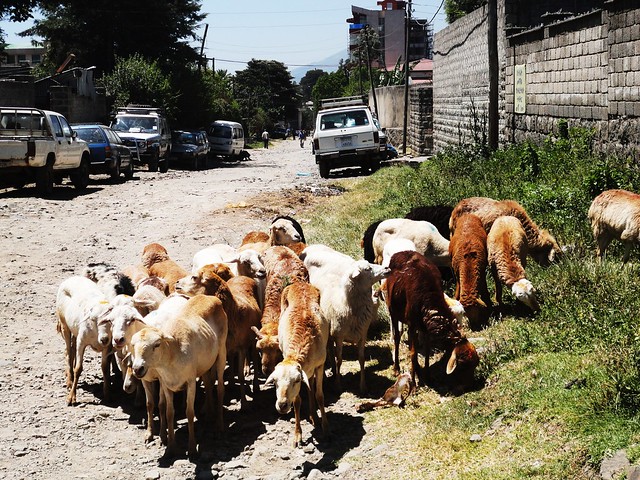
Editor’s note: In keeping with this week’s theme, Spacing Ottawa contributor Kathleen Courtney has sent us this post on the topic of urban food security from her current city of residence – Addis Ababa. Kathleen has been close to food as a server and cook in Ottawa restaurants and involved in food security issues as a Food for All participant and former policy student.
I have been living in Addis Ababa, the capital of Ethiopia, for one month. Through the Coady Institute, Nova Scotia, I am completing a work placement with an organization that supports pastoralists and smallholder farmers in Ethiopia. I am learning about the city’s inspiring food system and can see that in some ways, Ottawa and Addis can learn from one another.
The food here in Addis is what I call free food. Food seems to be available everywhere, and flows in and out of stores, homes with fewer strict regulations. What Ottawa considers local food, here is simply food. In the past month, everything I have eaten came from within the country. The food is natural, cooked from scratch and delicious. The trend of North American fast food businesses infiltrating foreign markets is not present here in Addis.
Recently I was standing on a sidewalk, among dozens of other people, waiting for a bus. Within five feet of where I was, several men were making furniture on the street for a small business. Beside them, a woman walked out of her home, with a rooster following her, and dumped out a pot of cooking water. In my residential neighbourhood it is obvious that livestock are part of urban life. Herders at times walk through with goats or sheep for sale, roosters are everywhere and butchers do house calls. Zoning laws do not restrict these types of activities in the city’s neighbourhoods.
Food outlets are also all over the city. My small neighbourhood, which is away from a busy road, has several. Addis’ free food seems to allow for the sale of food anywhere. It is normal to see stores that predominantly sell toiletries or hardware with boxes of potatoes and tomatoes for shoppers to pick up. It is common to see corn on the cob being roasted over a small fire on the street and typical convenience stores selling bulk rice, beans, eggs and produce. In many cases, meat is free food as well, especially when sold off the carcass in butcher shops, with no pre-packaging or plastic involved.
Enjoying the food culture in Addis is a novelty for me, but the city is far from being all rosy. Ethiopia sits at the low end of the United Nations’ Human Development Index, with a rating of 157 out of 169 countries, and this is blatantly obvious. While the economy is growing at a fast rate, it still plays a very small role in the global market. Interestingly, in its undeveloped state, Addis has a number of qualities many of us in developed Ottawa are after: fewer food deserts, street food minus the deep fryer, increased availability of local food, urban livestock and hen keeping and local food procurement at food services. All of this boils down to the issue of accessibility.
Studies show that one’s physical location in the city relates to his or her food choices. In neighbourhoods with food outlets that sell healthier food, even in low-income areas, individuals’ healthy food consumption increases. It’s simple, we are likely to eat what’s around us. In changing the landscape in Ottawa to include healthier, free food we are all better off.
While everyone in Ottawa benefits from a more accessible, wholesome food culture, and I’d like to emphasize that our point of reference regarding ease of access is unequal. A car-less new Canadian living on Rochester Street does not have the same degree of food access or knowledge of food outlet locations as a long-time Ottawa resident living in the middle of the Byward Market. Better access to food changes things significantly, in some cases, for persons with mental or physical disabilities, single parents, seniors, individuals working two or three jobs and stressed students.
A shift to a more food-friendly city in the ways described here – and by other Spacing posts – increases Ottawa’s physical accessibility standards in a huge way. Rather than a portion of Ottawa residents having to seek help or compromise his or her standards by choosing less healthy foods that may be closer to home, we foster a universal design.
Addis’ “keeping-it-real”, as great as it is, has to do with many factors including an unstable agriculture market and low levels of development. Still, this city, characterized as being behind Ottawa on a scale of developement is actually ahead of us in many ways.
